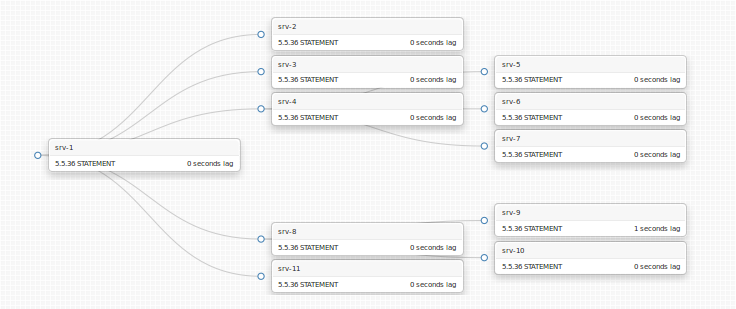If you’re running more than a few slaves in a replication topology, you might choose to use deeply nested replication: slaves replicating from other slaves at 2, 3 or even 4 levels. There are pros and cons to such topologies, discussed below.
A simple, small deep nested topology is depicted below (it is also a real production topology of ours):

Two slaves, srv-4 and srv-8 act as local masters to yet other slaves. Why would we want to have this complexity?
Pros
- Reduce load on master: too many slaves replicating from single master means the master becomes loaded with serving the binary logs. Typically, when all slaves are up to date, this isn’t a big deal, since they all get served roughly the same entries, and caching works great. If not all are in sync, the master needs to look up different log entries and pays with more disk I/O.
- Reduce network load. We serve from three different data centres. Our master is in one DC, and our slaves are spread through all three. Inter-DC network is naturally slower; it is also more expensive, hence more easily saturated. Reducing cross-DC network is done across all our systems, including MySQL. srv-4, for example, could depict a slave that is a local master in its own DC, serving srv-5, srv-6, srv-7 all in the same DC, hence only using cross-DC network for one slave instead of four. A bit over-simplistic example but true.
- Failover. MHA does a good job at synchronizing slaves of same master by figuring out the missing binary log entries for each slave. It should do well within a single region, but I do not know that it would do the same cross region (I’m assuming the binlog entries copy should work, but I haven’t tried it cross region). In case of a disaster such as an entire DC going down (we actually had such a case a couple weeks ago; power went out for the entire DC), we have a designated master into which we can fail over in each other DC, and which contains enough slaves (from each remaining DCs) to keep serving. That it, we’re willing to skip the fancy syncing and just point to a newly promoted master, with the benefit that the entire replication topology under it is intact.
- Testing & upgrades. For example, I might want to upgrade to 5.6. Upgrading a slave from 5.5 to 5.6 is a good start; we look at replication and see that nothing gets broken. But how will our production master behave with 5.6? Put some more slaves under your newly upgraded 5.6 server and get a clearer picture. At some stage you might just promote this entire subtree as the new topology.
Here’s another topology; DC info is not depicted in this image, but you can guess what designated masters we have: Continue reading » “Using deep nested replication topologies”

